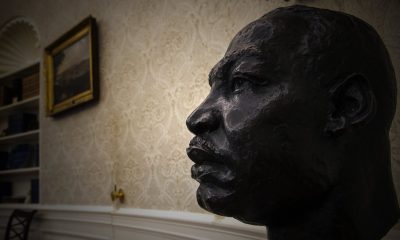Entertainment
Misty Copeland Is Promoted to Principal Dancer at American Ballet Theater

In this June 15, 2015 photo released by the American Ballet Theatre, dancer Misty Copeland performs in “Romeo and Juliet.” Copeland, the Missouri-born dancer who has become a forceful voice for diversity in ballet and a rare celebrity in that field, was named principal dancer at American Ballet Theatre on Tuesday, June 30, the first African-American ballerina to achieve that status in the company’s 75-year history. (Rosalie O’Connor/American Ballet Theatre via AP)
(New York Times) – Misty Copeland was fast becoming the most famous ballerina in the United States — making the cover of Time magazine, being profiled by “60 Minutes,” growing into a social media sensation and dancing ballet’s biggest roles on some of its grandest stages. But another role eluded her: She was still not a principal dancer.
Until Tuesday, when Ms. Copeland became the first African-American woman to be named a principal in the 75-year history of American Ballet Theater.
Even as her promotion was celebrated by her many fans, it raised all-too-familiar questions about why African-American dancers, particularly women, remain so underrepresented at top ballet companies in the 21st century, despite the work of pioneering black dancers who broke racial barriers in the past. And it showed how media and communications have changed in dance, with Ms. Copeland deftly using modern tools — an online ad she made for Under Armour has been viewed more than 8 million times — to spread her fame far beyond traditional dance circles, drawing new audiences to ballet.
Activism
Oakland Post: Week of May 21 – 27, 2025
The printed Weekly Edition of the Oakland Post: Week of May 21 – 27, 2025

To enlarge your view of this issue, use the slider, magnifying glass icon or full page icon in the lower right corner of the browser window.
Bo Tefu
Gov. Newsom Highlights Record-Breaking Tourism Revenue, Warns of Economic Threats from Federal Policies
“California dominates as a premier destination for travelers throughout the nation and around the globe,” said Newsom. “With diverse landscapes, top-rate attractions, and welcoming communities, California welcomes millions of visitors every year. We also recognize that our state’s progress is threatened by the economic impacts of this federal administration, and are committed to working to protect jobs and ensure all Californians benefit from a thriving tourism industry.”

By Bo Tefu, California Black Media
Last week, Gov. Gavin Newsom, along with the nonprofit organization Visit California, announced that tourism spending in California reached a record $157.3 billion in 2024, reinforcing the state’s status as the top travel destination in the United States.
The Governor made the announcement May 5, referencing Visit California’s 2024 Economic Impact Report, which highlights a 3% increase in tourism revenue over the previous year.
According to the report, California’s tourism sector supported 1.2 million jobs, generated $12.6 billion in state and local tax revenues, and created 24,000 new jobs in 2024.
“California dominates as a premier destination for travelers throughout the nation and around the globe,” said Newsom. “With diverse landscapes, top-rate attractions, and welcoming communities, California welcomes millions of visitors every year. We also recognize that our state’s progress is threatened by the economic impacts of this federal administration, and are committed to working to protect jobs and ensure all Californians benefit from a thriving tourism industry.”
Despite the gains in tourism revenue, Visit California’s revised 2025 forecast points to a 1% decline in total visitation and a 9.2% decrease in international travel. The downturn is attributed to federal economic policy and what officials are calling an impending “Trump Slump,” caused by waning global interest in traveling to the United States.
To offset projected losses, the Governor is encouraging Californians to continue traveling within the state and has launched a new campaign aimed at Canadian travelers.
Activism
BOOK REVIEW: The Afterlife of Malcolm X
Betty Shabazz didn’t like to go to her husband’s speeches, but on that February night in 1965, he asked her to come with their daughters to the Audubon Ballroom in New York. Did Malcolm X sense that something bad would happen on that night? Surely. He was fully aware of the possibility, knowing that he’d been “a marked man” for months because of his very public break with the Nation of Islam.

By Terri Schlichenmeyer
Author: by Mark Whitaker, c.2025, Simon & Schuster, $30.99, 448 pages
Who will remember you in fifty years’ time?
A handful of friends – at least those who are still around – might recall you. Your offspring, grandkids, and greats, maybe people who stumble upon your tombstone. Think about it: who will remember you in 2075? And then read “The Afterlife of Malcolm X” by Mark Whitaker and learn about a legacy that still resonates a half-century later.
Betty Shabazz didn’t like to go to her husband’s speeches, but on that February night in 1965, he asked her to come with their daughters to the Audubon Ballroom in New York. Did Malcolm X sense that something bad would happen on that night? Surely. He was fully aware of the possibility, knowing that he’d been “a marked man” for months because of his very public break with the Nation of Islam.
As the news of his murder spread around New York and around the world, his followers and admirers reacted in many ways. His friend, journalist Peter Goldman, was “hardly shocked” because he also knew that Malcolm’s life was in danger, but the arrest of three men accused of the crime didn’t add up. It ultimately became Goldman’s “obsession.”
Malcolm’s co-writer for The Autobiography of Malcolm X, Alex Haley, quietly finished the book he started with Malcolm, and a small upstart publishing house snatched it up. A diverse group of magazines got in line to run articles about Malcolm X’s life, finally sensing that White America “’needed his voice even more than Blacks did.’”
But though Malcolm X was gone, he continued to leave an impact.
He didn’t live long enough to see the official founding of the Black Panther Party, but he was influential on its beginning. He never knew of the first Kwanzaa, or the triumphs of a convert named Muhammad Ali.
Malcolm left his mark on music. He influenced at least three major athletes.
He was a “touchstone” for a president …
While it’s true that “The Afterlife of Malcolm X” is an eye-opening book, one that works as a great companion to the autobiography, it’s also a fact that it’s somewhat scattered. Is it a look at Malcolm’s life, his legacy, or is it a “murder mystery”?
Turns out, it’s all three, but the storylines are not smooth. There are twists and tangents and that may take some getting used-to. Just when you’re immersed, even absorbed in this book, to the point where you forget about your surroundings, author Mark Whitaker abruptly moves to a different part of the story. It may be jarring.
And yet, it’s a big part of this book, and it’s essential for readers to know the investigation’s outcome and what we know today. It doesn’t change Malcolm X’s legacy, but it adds another frame around it.
If you’ve read the autobiography, if you haven’t thought about Malcolm X in a while, or if you think you know all there is to know, then you owe it to yourself to find “The Afterlife of Malcolm X.”
For you, this is a book you won’t easily forget.
-

 #NNPA BlackPress3 weeks ago
#NNPA BlackPress3 weeks agoMLK Bust Quietly Removed from Oval Office Under Trump
-

 Activism3 weeks ago
Activism3 weeks agoOakland Post: Week of April 30 – May 6, 2025
-

 Activism3 weeks ago
Activism3 weeks agoOakland Post: Week of May 7 – 13, 2025
-

 #NNPA BlackPress3 weeks ago
#NNPA BlackPress3 weeks agoTrump Abruptly Fires First Carla Hayden: The First Black Woman to Serve as Librarian of Congress
-

 Activism1 week ago
Activism1 week agoNew Oakland Moving Forward
-

 #NNPA BlackPress3 weeks ago
#NNPA BlackPress3 weeks agoBlack America Celebrates African Descent Heritage of Pope Leo XIV
-

 Activism1 week ago
Activism1 week agoAfter Two Decades, Oakland Unified Will Finally Regain Local Control
-

 Alameda County1 week ago
Alameda County1 week agoOakland Begins Month-Long Closure on Largest Homeless Encampment





















































